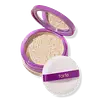What's inside
What's inside
 Key Ingredients
Key Ingredients

 Benefits
Benefits

 Concerns
Concerns

 Ingredients Side-by-side
Ingredients Side-by-side

Mica
Cosmetic ColorantSilica
AbrasiveDimethicone
EmollientMagnesium Myristate
Nylon-12
Ethylhexyl Palmitate
EmollientZea Mays Starch
AbsorbentDistarch Phosphate
AbsorbentKaolin
AbrasiveLauroyl Lysine
Skin ConditioningAscorbyl Palmitate
AntioxidantTocopherol
AntioxidantPhenoxyethanol
PreservativePolymethyl Methacrylate
Ethylhexylglycerin
Skin ConditioningMethicone
EmollientTitanium Dioxide
Cosmetic ColorantIron Oxides
Talc
AbrasiveMica
Cosmetic ColorantCI 77891
Cosmetic ColorantMagnesium Myristate
Dimethicone
EmollientNylon-12
Polyethylene
AbrasiveSilica
AbrasivePolymethyl Methacrylate
Phenoxyethanol
PreservativePhenyl Trimethicone
Skin ConditioningZea Mays Starch
AbsorbentCI 19140
Cosmetic ColorantSodium Dehydroacetate
PreservativeSqualane
EmollientCI 77491
Cosmetic ColorantAscorbyl Palmitate
AntioxidantBHT
AntioxidantCI 77007
Cosmetic ColorantCI 77492
Cosmetic ColorantCI 77002
Cosmetic ColorantCI 73360
Cosmetic ColorantCI 77499
Cosmetic ColorantTocopheryl Acetate
AntioxidantTalc, Mica, CI 77891, Magnesium Myristate, Dimethicone, Nylon-12, Polyethylene, Silica, Polymethyl Methacrylate, Phenoxyethanol, Phenyl Trimethicone, Zea Mays Starch, CI 19140, Sodium Dehydroacetate, Squalane, CI 77491, Ascorbyl Palmitate, BHT, CI 77007, CI 77492, CI 77002, CI 73360, CI 77499, Tocopheryl Acetate
Ingredients Explained
These ingredients are found in both products.
Ingredients higher up in an ingredient list are typically present in a larger amount.
Ascorbyl Palmitate is created by combining pure Vitamin C and palmitic acid. It is an antioxidant and helps reduce hyperpigmentation.
This ingredient is a more stable version of Vitamin C, meaning it does not disintegrate as quickly when exposed to sunlight. However, studies show it does not penetrate skin as well as pure Vitamin C.
Ascorbyl Palmitate is oil soluble.
Read more about other types of Vitamin C:
Learn more about Ascorbyl PalmitateDimethicone is a type of synthetic silicone created from natural materials such as quartz.
What it does:
Dimethicone comes in different viscosities:
Depending on the viscosity, dimethicone has different properties.
Ingredients lists don't always show which type is used, so we recommend reaching out to the brand if you have questions about the viscosity.
This ingredient is unlikely to cause irritation because it does not get absorbed into skin. However, people with silicone allergies should be careful about using this ingredient.
Note: Dimethicone may contribute to pilling. This is because it is not oil or water soluble, so pilling may occur when layered with products. When mixed with heavy oils in a formula, the outcome is also quite greasy.
Learn more about DimethiconeWe don't have a description for Magnesium Myristate yet.
Mica is a naturally occurring mineral used to add shimmer and color in cosmetics. It can also help improve the texture of a product or give it an opaque, white/silver color.
Serecite is the name for very fine but ragged grains of mica.
This ingredient is often coated with metal oxides like titanium dioxide. Trace amounts of heavy metals may be found in mica, but these metals are not harmful in our personal products.
Mica has been used since prehistoric times throughout the world. Ancient Egyptian, Indian, Greek, Roman, Aztec, and Chinese civilizations have used mica.
Learn more about MicaNylon-12 is a polymer. It is derived from 12-aminododecanoic acid, an omega-amino fatty acid
According to a manufacturer, it is a talc substitute. Like talc, nylon-12 gives products a satin feel. The manufacturer also claims this ingredients does not block pores and has moderate oil absorption.
This ingredient may not be reef-safe.
Learn more about Nylon-12Phenoxyethanol is a preservative that has germicide, antimicrobial, and aromatic properties. Studies show that phenoxyethanol can prevent microbial growth. By itself, it has a scent that is similar to that of a rose.
It's often used in formulations along with Caprylyl Glycol to preserve the shelf life of products.
This ingredient is also known as PMMA. It is a polymer microsphere, composed of tiny, perfectly spherical particles formed from repeating units.
In cosmetics, PMMA is mainly used to give a soft or blurring effect. The transparent particles are able to scatter light and help reduce the appearance of fine-lines and imperfections.
PMMA is also able to enhance the texture of products by add a smooth feel.
Learn more about Polymethyl MethacrylateSilica, also known as silicon dioxide, is a naturally occurring mineral. It is used as a fine, spherical, and porous powder in cosmetics.
Though it has exfoliant properties, the function of silica varies depending on the product.
The unique structure of silica enhances the spreadability and adds smoothness, making it a great texture enhancer.
It is also used as an active carrier, emulsifier, and mattifier due to its ability to absorb excess oil.
In some products, tiny microneedles called spicules are made from silica or hydrolyzed sponge. When you rub them in, they lightly polish away dead skin layers and enhance the penetration of active ingredients.
Learn more about SilicaZea Mays Starch is starch made from corn. You might know this as cornstarch . It is used to thicken a product. It can replace talc as an absorbent.
The pH of cornstarch is 5.92.
Cornstarch is a common food ingredient used to thicken soups or to make corn syrup.
Learn more about Zea Mays Starch